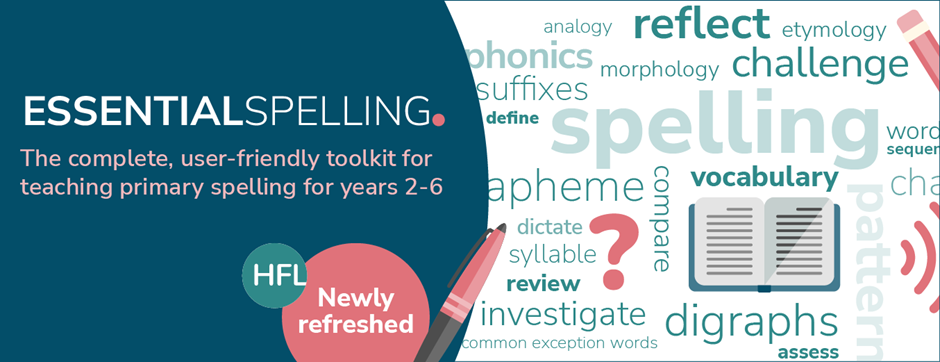Why is spelling on trend?
With the publication of DfE’s writing framework, spelling has stepped firmly into the spotlight. For children, accurate spelling shouldn’t be about ticking boxes or passing weekly tests. The research referenced by the framework underpins the notion that when pupils are able to spell well with automaticity, they have adequate working memory - or cognitive space - to focus on crafting sentences and shaping ideas. When children spend less energy worrying about spelling, they can channel their creativity into writing that speaks to the reader.
The STA’s KS2 Teacher Assessment Framework also makes it clear: pupils must demonstrate secure spelling knowledge to meet age-related expectations (this is under review following the Curriculum and Assessment Review. Embedded spelling application is unlikely to disappear – even if the SPAG test were to change). Demonstrating this secure knowledge doesn’t have to mean shoehorning word lists into writing. Instead, it can be about embedding spelling teaching and learning into meaningful contexts and helping pupils develop strategies that last a lifetime. Spelling teaching doesn’t have to be dry or daunting. With the right strategies, it can become a source of curiosity and empowerment for pupils - and teachers too.
The big picture: From phonics to morphology
Spelling is a journey. In Early Years and KS1, phonics teaching lays the foundation, but at KS2, pupils need to combine this knowledge to embrace morphemic and etymological strategies. This combination of understanding – the ‘tapestry of spelling knowledge’ (Adoniou, 2013) - is crucial for independence and automaticity. A spelling curriculum should attend to each of these aspects, teaching children how words are built and sparking their curiosity about the patterns in the English language.
Let’s consider the knowledge that makes up the tapestry of spelling:
- Phonological & orthographical knowledge:
Both are vital in KS2. Indeed, many GPCs continue to appear on the KS2 Programme of Study for spelling in the national curriculum all the way up to year 6, so we can’t let pupils abandon ‘if in doubt, sound it out.’ However, we can extend this by asking, ‘what’s the best bet for that phoneme in that position?’. This orthographic knowledge is essential for children to grasp in order to develop effortless transcription (and it’s necessary for reading!). Orthography refers to the common letter patterns and their likely position in a word – such as recognising that the ‘ai’ spelling pattern is unlikely to be found at the end of a word, for example – as well as spelling rules or conventions such as knowing when to double or drop the last consonant of a word before adding the ‘ing’ suffix. Some children struggle to move beyond ‘right phoneme, wrong grapheme’ but with orthography explicitly taught, they are more likely to overcome it quickly. - Morphological knowledge:
Teach prefixes, suffixes, and root words explicitly. Understanding word structure helps pupils tackle unfamiliar vocabulary and understand why words such as disappear have one s whilst dissolve has two! - Etymological knowledge:
Teaching word origins can spark curiosity and deepen understanding. Share the stories behind spellings. As David Crystal reminds us, ‘explaining why words are spelled the way they are helps us remember them.’ A quick anecdote about why ‘to’, ‘too’ and ‘two’ differ can spark interest and help to make rules stick.
Top tips for teachers
- Make Spelling Visible Across the Curriculum
Display target words on working walls and weave them into modelled writing. Externalise your thought process when choosing words; show pupils how spelling and vocabulary choices shape meaning. - Celebrate Curiosity
Introduce a Spelling Wonder Wall where pupils post puzzling questions: Why is there a ‘w’ in two? What’s the link between ‘secret’ and ‘secretary’? This shifts the mindset from fear to fascination. - Keep It Active and Fun
Spelling shouldn’t feel like a chore. Try these quick-fire activities:
- Prefix Power:
Split the class into groups, each with a prefix (e.g., sub, inter, auto). Give two minutes to list as many words as possible, then discuss meanings. - Speedy Etymology:
Pairs race to find as many words linked to the root of a word in 30 seconds (e.g., spect, bene). - Word Ladders:
Start with a word (e.g., brain) and build a chain where each word begins with the last letter of the previous one. - Words Within Words:
How many smaller words can pupils find inside or using the letters from explanation or determined?
- Draw attention to the ‘tricky bit’
When adding spelling or vocabulary to the working wall, draw attention to the ‘tricky bit’ of the word. Most words aren’t difficult to spell all the way through and if pupils build on the knowledge that they do know, words that don’t fit common patterns are more likely to ‘go in’. For example, in the word friend, the i is likely to be causing the trouble. Children can assign the other graphemes easily so I would write that one up with the i in bold and in another colour. (e.g., friend, plant, again)
Practical classroom ideas
- Treasure Hunt Challenges:
Find the word with the longest vowel chain (queue), or the most double consonants (committee). These games build pattern recognition and spark discussion. - Grammar Meets Spelling:
Try the Number Plate Game - use three letters from a car registration number plate to create sentences. Vary by requiring a verb, adverb, or proper noun to reinforce grammar alongside spelling. - Cross-Curricular Links:
Highlight spelling patterns during guided reading or science lessons for example (e.g. states of matter in science is great for reinforcing those -ation words!). Repeated encounters in different contexts help words stick. - Morpheme Matrix:
Provide a root word and challenge pupils to see how many words they can create by adding different prefixes and suffixes.
Assessment
Tracking matters, but it doesn’t need to feel overwhelming. Use phonics and spelling trackers to identify gaps and inform interventions. These assessments are far better made from the scrutiny of independent writing, rather than outcomes from spelling tests. We can all think of children who do well each week in the test and then don’t apply the knowledge in their writing! Getting diagnostic helps too. Ask yourself which words are frequently being misspelt? For example, are they mainly those past tense verb endings, or homophones? It’s likely that a pupil requiring support will have strengths in some areas and weaknesses in others so an intervention or targeted teaching which addresses their specific gaps only will yield swift results. Progress is better measured through secure application of strategies, not rote memorisation. When pupils understand why words are spelled as they are, confidence grows and so does writing quality.
Final thoughts
Spelling is complex, but it’s also fascinating. Effective teaching of spelling offers rich opportunity for language exploration and therefore improved vocabulary confidence too. By embedding spelling instruction within meaningful contexts and presenting it as a logical system rather than a series of arbitrary rules, we can nurture both competence and curiosity. When pupils understand the principles behind spelling and encounter them through engaging, purposeful activities, they develop confidence and independence. In doing so, spelling becomes not a barrier, but a foundation for high-quality writing. HFL’s ESSENTIALSPELLING curriculum provides a clear, structured approach to teaching spelling, helping pupils build confidence and mastery through engaging, evidence-based strategies.
References:
Misty Adoniou (2013), What should teachers know about spelling?




